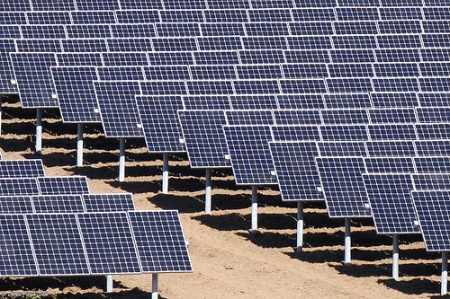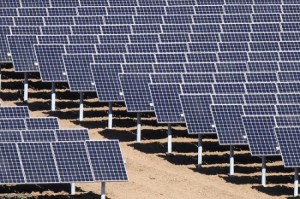It’s a safe bet that no one in this quaint little railroad town, with its cotton-processing operations and Main Street cannery, ever expected to see a farm quite like the one sprouting a few miles down the road.
Located along Interstate 40 on 35 acres of newly cleared land that bakes under the July sun, the West Tennessee Solar Farm is growing into an otherworldly latticework of pilings and metal racks pointed southward.

By the end of this week, the contracting firm Signal Energy should begin mounting 21,000 solar panels onto the racks. And when work is finished early next year, it will be the largest utility-scale solar installation in the state and one of the biggest in the Southeast, producing enough clean, renewable power for more than 1,000 homes.
The $31 million project, funded by a Department of Energy grant the state received under the federal stimulus bill, will generate electricity to be sold to the Tennessee Valley Authority and distributed on its grid. A second phase, now on hold, will include construction of a welcome center that will highlight for motorists the potential of solar power.
“The point is not only to demonstrate commercial-scale production (of solar power) but to have this public-education component to it,” said Paula Flowers, project director for the University of Tennessee Research Foundation, which is managing the solar farm.
This 5-megawatt project, on a site in Haywood County less than 40 miles northeast of Memphis, is the latest and most prominent of several solar initiatives across Tennessee and the Mid-South.
Only a half-hour farther up I-40 from the Haywood project lies another solar array in Jackson, Tenn. Located at a former factory in an industrial park, it includes a 1-megawatt generating facility selling power to the TVA and a 47-kilowatt array to provide electricity for the industrial site.
In addition, a 1-megawatt solar-generating facility is under development at the Smyrna, Tenn., airport. It will include a charging station for Nissan Leaf electric vehicles.
Solar’s growth is hardly a regional phenomenon. Nationwide, the solar-power industry grew 67 percent in 2010 — more than any other U.S. industry, according to the Solar Energy Industries Association.
Still, solar energy produced less than 1 percent of the electricity generated in the U.S. last year, according to federal statistics.
The recent projects show that solar energy, despite its limitations, has plenty of room for growth in Tennessee, industry officials say.
“It’s no magic bullet,” said Harvey Abouelata, a territory manager for the firm Choice Solar who helped launch a number of solar initiatives.
Abouelata sees solar as a “great complement” to a mix of energy sources that should be used. Although limited by weather, available space and daylight hours, it’s especially useful during summer months when air-conditioning needs strain electrical demand.
“It performs best when our need is up,” he said.
Cost is another obstacle to greater solar development. A report by the Energy Information Administration last year estimated that the “levelized cost” of building and operating a solar generating facility remains more than twice that of a conventional coal plant.
The cost gap is especially pronounced in the TVA region, where wholesale power rates remain lower than in many parts of the country, said Robbie Thomas, president of Efficient Energy of Tennessee, which installed the project in Jackson.
“As long as your power’s cheap, it’s a big leap” to solar, Thomas said.
The government subsidies and tax credits available to purchasers of solar power have helped make it a more attractive option.
But the market also has played a part. With an increasingly competitive field of manufacturers, prices for solar panels have dropped significantly in recent months, Thomas said.
Abouelata also noted that the “true cost” of conventional energy sources has become more apparent with recent environmental disasters that include the Gulf of Mexico oil leak last year, the massive coal-ash spill near Kingston, Tenn., in 2008 and the nuclear crisis following the earthquake and tsunami in Japan four months ago.
“Now that people are more aware (of those costs), they’re making better choices,” Abouelata said.
The solar industry employs about 100,000 people nationwide and about 1,000 in the Memphis area.
The largest contingent of those workers can be found at the Sharp Manufacturing Co. facility on Mendenhall, which employs about 400 and makes solar panels.
The Sharp plant, one of the nation’s leading solar manufacturers, made the panels for the Jackson generating facility. But the panels for the solar farm near Stanton were made by a Suniva Inc. plant in Norcross, Ga.
Flowers said Sharp submitted proposals to supply panels for the project. But Signal Energy, the contractor selected to build and design the facility, decided to use Suniva’s panels.
Although the initial capacity for the solar farm is 5 megawatts, it is being built to accommodate growth to 10 megawatts. Under the terms of the grant, all revenues from the sale of power must be directed back into the solar farm.

 Follow
Follow